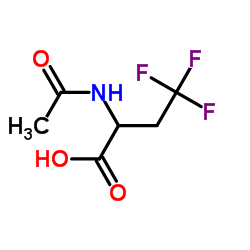15960-05-1
| 中文名 | 2-氨基-4,4,4-三氟丁酸 |
|---|---|
| 英文名 | 2-amino-4,4,4-trifluorobutyric acid |
| 英文别名 |
2-Amino-4,4,4-trifluorobutyric acid
S-Propyl-L-homocysteine L-Propionine MFCD00041417 S-Propyl-L-homocystein 2-Amino-4,4,4-trifluor-L-buttersaeure Propionine L-Homocysteine,S-propyl |
| 密度 | 1.432g/cm3 |
|---|---|
| 沸点 | 185.2ºC at 760mmHg |
| 熔点 | 260-265ºC |
| 分子式 | C4H6F3NO2 |
| 分子量 | 157.09100 |
| 闪点 | 65.8ºC |
| 精确质量 | 157.03500 |
| PSA | 63.32000 |
| LogP | 1.05100 |
| 蒸汽压 | 0.321mmHg at 25°C |
| 折射率 | 1.391 |
| 储存条件 | 室温, 避光, 惰性气体 |
| 分子结构 | 五、分子性质数据: 1、 摩尔折射率:26.09 2、 摩尔体积(m3/mol):109.6 3、 等张比容(90.2K):263.1 4、 表面张力(dyne/cm):33.1 5、 极化率(10-24cm3):10.34 |
| 计算化学 | 1、疏水参数计算参考值(XlogP):-1.2 2、氢键供体数量:.1 3、氢键受体数量:5 4、可旋转化学键数量:1 5、互变异构体数量: 6、拓扑分子极性表面积(TPSA):67.8 7、重原子数量:10 8、表面电荷:0 9、复杂度:127 10、同位素原子数量:0 11、确定原子立构中心数量:1 12、不确定原子立构中心数量:0 13、确定化学键立构中心数量:0 14、不确定化学键立构中心数量:0 15、共价键单元数量:1 |
| 更多 | 1.性状:未确定 2.密度(g/mL,25/4℃):未确定 3.相对蒸汽密度(g/mL,空气=1):未确定 4.熔点(ºC):260-265 5.沸点(ºC,常压):未确定 6.沸点(ºC,5.2kPa):未确定 7.折射率:未确定 8.闪点(ºC):未确定 9.比旋光度(º):未确定 10.自燃点或引燃温度(ºC):未确定 11.蒸气压(kPa,25ºC):未确定 12.饱和蒸气压(kPa,60ºC):未确定 13.燃烧热(KJ/mol):未确定 14.临界温度(ºC):未确定 15.临界压力(KPa):未确定 16.油水(辛醇/水)分配系数的对数值:未确定 17.爆炸上限(%,V/V):未确定 18.爆炸下限(%,V/V):未确定 19.溶解性:未确定 |
Synonym:3-Trifluoromethylalanin Section 2 - COMPOSITION, INFORMATION ON INGREDIENTS
Risk Phrases: 36/37/38 Section 3 - HAZARDS IDENTIFICATION EMERGENCY OVERVIEW
Irritating to eyes, respiratory system and skin.The toxicological properties of this material have not been fully investigated. Potential Health Effects Eye: Causes eye irritation. Skin: Causes skin irritation. Ingestion: May cause irritation of the digestive tract. The toxicological properties of this substance have not been fully investigated. Inhalation: Causes respiratory tract irritation. The toxicological properties of this substance have not been fully investigated. Chronic: No information found. Section 4 - FIRST AID MEASURES Eyes: Flush eyes with plenty of water for at least 15 minutes, occasionally lifting the upper and lower eyelids. Get medical aid. Skin: Get medical aid. Flush skin with plenty of water for at least 15 minutes while removing contaminated clothing and shoes. Wash clothing before reuse. Ingestion: If victim is conscious and alert, give 2-4 cupfuls of milk or water. Get medical aid. Wash mouth out with water. Inhalation: Remove from exposure and move to fresh air immediately. If not breathing, give artificial respiration. If breathing is difficult, give oxygen. Get medical aid. Notes to Physician: Antidote: None reported. Section 5 - FIRE FIGHTING MEASURES General Information: As in any fire, wear a self-contained breathing apparatus in pressure-demand, MSHA/NIOSH (approved or equivalent), and full protective gear. Extinguishing Media: Use water spray, dry chemical, carbon dioxide, or chemical foam. Section 6 - ACCIDENTAL RELEASE MEASURES General Information: Use proper personal protective equipment as indicated in Section 8. Spills/Leaks: Vacuum or sweep up material and place into a suitable disposal container. Clean up spills immediately, observing precautions in the Protective Equipment section. Avoid generating dusty conditions. Provide ventilation. Section 7 - HANDLING and STORAGE Handling: Wash thoroughly after handling. Remove contaminated clothing and wash before reuse. Minimize dust generation and accumulation. Avoid contact with eyes, skin, and clothing. Avoid ingestion and inhalation. Use only in a chemical fume hood. Storage: Store in a tightly closed container. Store in a cool, dry, well-ventilated area away from incompatible substances. Section 8 - EXPOSURE CONTROLS, PERSONAL PROTECTION Engineering Controls: Use adequate ventilation to keep airborne concentrations low. Exposure Limits CAS# 15960-05-1: Personal Protective Equipment Eyes: Wear appropriate protective eyeglasses or chemical safety goggles as described by OSHA's eye and face protection regulations in 29 CFR 1910.133 or European Standard EN166. Skin: Wear appropriate protective gloves to prevent skin exposure. Clothing: Wear appropriate protective clothing to prevent skin exposure. Respirators: Follow the OSHA respirator regulations found in 29 CFR 1910.134 or European Standard EN 149. Use a NIOSH/MSHA or European Standard EN 149 approved respirator if exposure limits are exceeded or if irritation or other symptoms are experienced. Section 9 - PHYSICAL AND CHEMICAL PROPERTIES Physical State: Solid Color: Not available. Odor: No apparent odor. pH: Not available. Vapor Pressure: Not available. Viscosity: Not available. Boiling Point: Not available. Freezing/Melting Point: 256 deg C dec Autoignition Temperature: Not available. Flash Point: Not available. Explosion Limits, lower: Not available. Explosion Limits, upper: Not available. Decomposition Temperature: Solubility in water: Specific Gravity/Density: Molecular Formula: C4H6F3NO2 Molecular Weight: 157.09 Section 10 - STABILITY AND REACTIVITY Chemical Stability: Stability unknown. Conditions to Avoid: Incompatible materials, dust generation. Incompatibilities with Other Materials: Strong acids, strong bases, strong oxidizing agents, strong reducing agents. Hazardous Decomposition Products: Nitrogen oxides, carbon monoxide, carbon dioxide, hydrogen fluoride gas. Hazardous Polymerization: Has not been reported. Section 11 - TOXICOLOGICAL INFORMATION RTECS#: CAS# 15960-05-1 unlisted. LD50/LC50: Not available. Carcinogenicity: 2-Amino-4,4,4-trifluorobutyric acid - Not listed by ACGIH, IARC, or NTP. Section 12 - ECOLOGICAL INFORMATION Other No information available. Section 13 - DISPOSAL CONSIDERATIONS Dispose of in a manner consistent with federal, state, and local regulations. Section 14 - TRANSPORT INFORMATION IATA Not regulated as a hazardous material. IMO Not regulated as a hazardous material. RID/ADR Not regulated as a hazardous material. Section 15 - REGULATORY INFORMATION European/International Regulations European Labeling in Accordance with EC Directives Hazard Symbols: XI Risk Phrases: R 36/37/38 Irritating to eyes, respiratory system and skin. Safety Phrases: S 26 In case of contact with eyes, rinse immediately with plenty of water and seek medical advice. S 37/39 Wear suitable gloves and eye/face protection. WGK (Water Danger/Protection) CAS# 15960-05-1: No information available. Canada None of the chemicals in this product are listed on the DSL/NDSL list. CAS# 15960-05-1 is not listed on Canada's Ingredient Disclosure List. US FEDERAL TSCA CAS# 15960-05-1 is not listed on the TSCA inventory. It is for research and development use only. SECTION 16 - ADDITIONAL INFORMATION N/A |
| 危害码 (欧洲) | Xi |
|---|---|
| 风险声明 (欧洲) | R36/37/38 |
| 安全声明 (欧洲) | S26;S37/S39 |
|
~94% 
15960-05-1 |
| 文献:Tsushima; Kawada; Ishihara; Uchida; Shiratori; Higaki; Hirata Tetrahedron, 1988 , vol. 44, # 17 p. 5375 - 5387 |
|
~% 
15960-05-1 |
| 文献:Angewandte Chemie, , vol. 79, # 17/18 p. 822 - 823 |
| 上游产品 1 | |
|---|---|
| 下游产品 0 | |


